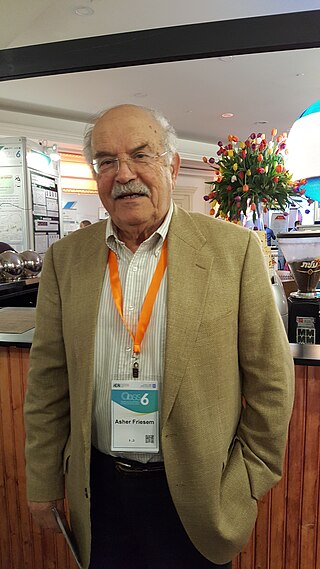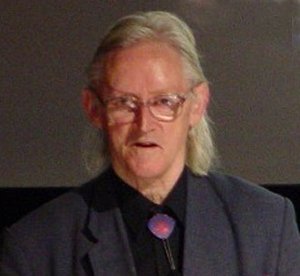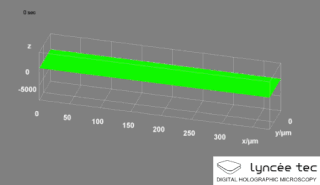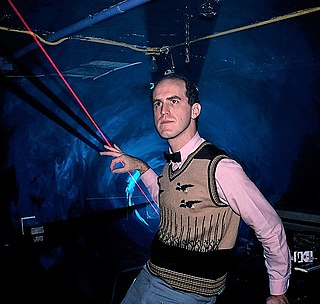
Holography is a technique that enables a wavefront to be recorded and later reconstructed. It is best known as a method of generating three-dimensional images, and has a wide range of other uses, including data storage, microscopy, and interferometry. In principle, it is possible to make a hologram for any type of wave.

The Holodeck is a fictional device from the television franchise Star Trek which uses "holograms" to create a realistic 3D simulation of a real or imaginary setting, in which participants can freely interact with the environment as well as objects and characters, and sometimes a predefined narrative.

EOTECH is an American company that designs, manufactures, and markets electro-optic and night vision products and systems. The company is headquartered in Plymouth, Michigan. They produce holographic weapon sights for small arms that have been adopted by various military and law enforcement agencies as close quarters battle firearm sights.
Lloyd Cross is an American physicist and holographer.
Holographic interferometry (HI) is a technique which enables the measurements of static and dynamic displacements of objects with optically rough surfaces at optical interferometric precision. These measurements can be applied to stress, strain and vibration analysis, as well as to non-destructive testing and radiation dosimetry. It can also be used to detect optical path length variations in transparent media, which enables, for example, fluid flow to be visualised and analyzed. It can also be used to generate contours representing the form of the surface.

Yuri Nikolayevich Denisyuk was a Russian physicist and one of the founders of optical holography in the former Soviet Union. He is known for his great contribution to holography, in particular for the so-called "Denisyuk hologram". He was a full member of the Russian Academy of Sciences, doctor of physical and mathematical sciences, professor (1980).

Stephen Anthony Benton was the inventor of the rainbow hologram and a pioneer in medical imaging and fine arts holography. Benton held 14 patents in optical physics and photography, and taught media arts and sciences at Massachusetts Institute of Technology (MIT). He was the E. Rudge ('48) and Nancy Allen Professor of Media & Sciences, and the Director for Center for Advanced Visual Studies (CAVS) at MIT.

Australian Holographics was a laboratory based in Adelaide, South Australia. It was established in 1989 with the specific objective to produce high quality large format holograms. After two years of research and development, the company began commercial operations in 1991. The laboratory eventually shut down in 1998.

Asher A. Friesem is a professor at the Weizmann Institute of Science in Israel.

Nicholas (Nick) John Phillips was an English physicist, notable for the development of photochemical processing techniques for the colour hologram. Holograms typically used to have low signal-to-noise ratios, and Phillips is credited as the pioneer of silver halide holographic processing techniques for producing high-quality reflection holograms.
A holographic display is a type of 3D display that utilizes light diffraction to display a three-dimensional image to the viewer. Holographic displays are distinguished from other forms of 3D displays in that they do not require the viewer to wear any special glasses or use external equipment to be able to see the image, and do not cause the vergence-accommodation conflict.

Digital holographic microscopy (DHM) is digital holography applied to microscopy. Digital holographic microscopy distinguishes itself from other microscopy methods by not recording the projected image of the object. Instead, the light wave front information originating from the object is digitally recorded as a hologram, from which a computer calculates the object image by using a numerical reconstruction algorithm. The image forming lens in traditional microscopy is thus replaced by a computer algorithm. Other closely related microscopy methods to digital holographic microscopy are interferometric microscopy, optical coherence tomography and diffraction phase microscopy. Common to all methods is the use of a reference wave front to obtain amplitude (intensity) and phase information. The information is recorded on a digital image sensor or by a photodetector from which an image of the object is created (reconstructed) by a computer. In traditional microscopy, which do not use a reference wave front, only intensity information is recorded and essential information about the object is lost.
Specular holography is a technique for making three dimensional imagery by controlling the motion of specular glints on a two-dimensional surface. The image is made of many specularities and has the appearance of a 3D surface-stippling made of dots of light. Unlike conventional wavefront holograms, specular holograms do not depend on wave optics, photographic media, or lasers.

Yves Gentet is a French engineer and artist, known for the invention of a creative method of holograms in colour Ultimate and a 3D holographic printer Chimera.

A holographic weapon sight or holographic diffraction sight is a non-magnifying gunsight that allows the user to look through a glass optical window and see a holographic reticle image superimposed at a distance on the field of view. The hologram of the reticle is built into the window and is illuminated by a laser diode.

Dieter Jung is a German artist working in the field of holography, painting and installation art. He lives and works in Berlin.
Wenyon & Gamble is the name used by the art team of Susan Gamble and Michael Wenyon.

Jason Sapan, also known as Dr. Laser is a holographer and actor who is the founder of Holographic Studios, the world's oldest gallery of holography, located in the borough of Manhattan in New York City. He is one of the pioneers of holography, and has also worked as an educator, recording engineer, artist, blogger, and actor. He has created portrait holograms of Andy Warhol, President Bill Clinton, Isaac Asimov, NYC Mayor Ed Koch, Prime Minister Edward Heath, Pierre Cardin, Sally Jessy Raphael, John Kenneth Galbraith, Phyllis Diller, Billy Idol, The Smothers Brothers, Phil Donahue, and John Cage. His corporate clientele include commissions for Mitsubishi, AT&T, Tag Heuer, Goodyear, IBM and NYU Medical Center.
Margaret Benyon,, was a British artist. Trained as a painter, she was one of the first artists to use holography as a medium and had her first solo show of holograms in 1969. She was appointed to the Order of the British Empire in 2000 for her service to art and has been called "the mother of British holography".

Matthew Schreiber is an American artist who is known for his work in holography and for his large scale laser light sculptures. Matthew Schreiber produces work in a wide variety of mediums, including drawing, performance, sculpture, video, and light. Recurring subjects within Schreiber's work center on novelty, the occult, and spectacle by using tools of physics, technology and perception. He has exhibited his work internationally, and most recently at large music festivals, an example of which can be found in his 2018 installation at Dark MOFO in Tasmania, in which Schreiber created a massive laser-light installation that completely immersed viewers.














